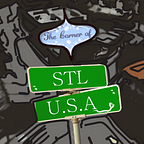Meet Eugenia Alexander
Eugenia Alexander is a multidisciplinary artist who, for over twelve years, has graced the Midwest with her signature indigo patterns and paintings of brightly colored leaves and hands. I first saw her indigo work at a Black Art Showcase event on Cherokee Street. I especially like her bold use of color and sleek doodled faces that always hide an underlying history and meaning. For example, reaching hands used repetitively at times, signifies the desire of Black people who long for more. They stretch out on her canvas like a cry from unheard voices. For Alexander, she uses hands so often because we use our hands the most out of every part on the body.
We are in unique territory as the black communities wrestle with both a revolution, and a pandemic in the 21st century. In looking at Alexander’s creations, it’s undeniable that the art born from this time will be special. Shesees herself as an art activist staying purposeful with what she creates. We’ve been exposed to so many raw images online, things we shouldn’t have to just see while casually scrolling. Breonna Tayler and Sandra Bland’s faces are engraved in my head. Diamond Reynolds’ voice, crying for her dead boyfriend Philando Castile, echoes in my ears. Alexander’s piece off of Delmar, done in collaboration with PaintedBlackStl, reveals the names of those murdered during this revolution. When the sun shines, the gold painted names glow in its radiance.
Indigo Art
Indigo itself is an aged art. The ancient technique dates back 6,000 years being one of the only natural dyes people used to color their clothes. This tradition of indigo dying originated in Asian and African countries, where the plant can best survive. Farming this plant is worth all the hard work for the amount of that rich blue color you can only get from indigo. Before blue dye was synthetically made, this color had wealth attached. The dye was exported to Europe giving only the wealthy access to it.
Alexander is working to start her own indigo farm in East St Louis, on land that’s right around the corner from her grandmother’s home. She’s envisioned a community garden for the neighborhood and a center for people to come together to learn how to plant and harvest their own foods. I love that her art transcends just a canvas. She is an artist who has a mission to transform her community from a food dessert to a thriving eco center of urban agriculture. With the help of a recently awarded grant from …..she will do just that!
Art in Session
I got to watch Alexander teach a small group of kids how to make their own indigo masterpieces. The class was given three pieces of fabric and used three different techniques for a design. After everyone either carefully mapped out or randomly placed the rubber bands or clothes pins onto their fabric, the marinating began. Alexander dunked her long stick and bare hands into blue stained white buckets as she mixed the natural dye into the fabric.
After the fabric sat in the bucket like a melting pot, everyone pulled their pieces out and slowly unraveled them. When the sun hit the dyed cloth, it turned the fabric green. Over time the famous indigo color shown through. This process was like developing a Polaroid picture, with the kids anxiously awaiting the final product. Watching the fabric turn from green to blue was my favorite part. Their favorite part was that everyones came out completely different.
As the kids wrapped up the session, they helped Alexander harvest black walnuts from my yard. She can use those to make a rich brown fabric dye. In a world where everything can be synthetically dyed, this seems like a momentous process. But there’s a beauty in recreating what our ancestors may have done and then teaching a younger generation, who will hopefully teach another generation.
